The Microsoft Surface Laptop 3 Showdown: AMD's Ryzen Picasso vs. Intel's Ice Lake
by Brett Howse & Andrei Frumusanu on December 13, 2019 8:30 AM ESTSystem Performance
Moving on from SPEC to some of our more traditional laptop tests, I’ve taken the opportunity to add some new tests to the suite, which we’ll include on all laptops going forward. While SPEC is a fantastic set of tests to probe the limits of a platform, not everyone is going to run a workload that runs at nearly 100% CPU utilization for such a long time on a laptop. The 8-Thread tests took 4.5 hours to complete on Ice Lake, and 6.5 hours to complete on Picasso, which is likely not something most people would turn to a thin and light laptop for, so it’s important to see how both platforms perform on shorter tests where they can leverage their peak boost frequencies for a higher percentage of the duration.
PCMark 10
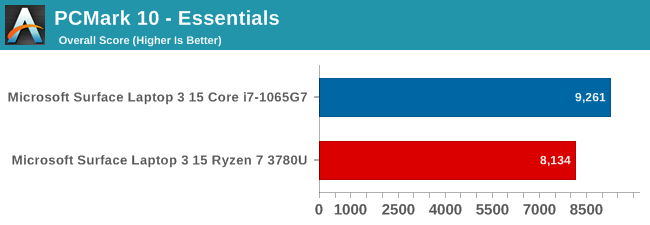

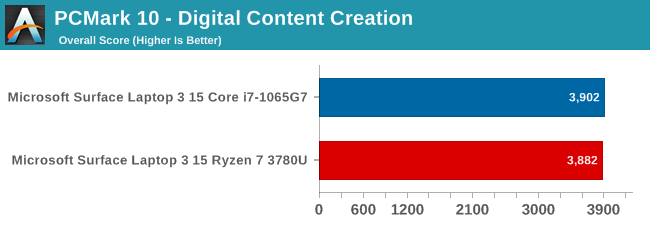
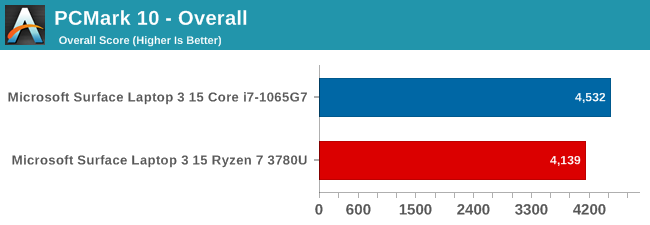
PCMark 10 consists of several real-world tests, including web, video conferencing, spreadsheets, writing, and more. There are several GPU tests as well, including rendering, and some gaming. The suite also measures application start-up, and all aspects of the system’s performance factor into the score.
Intel’s CPU performance lead shows clearly here again, with significant leads in both the Essentials and Productivity tests, although AMD’s strong GPU pulls the Ryzen system very close on the Digital Content Creation tasks. But that is not enough to turn the tide, and the Ice Lake platform carries this win.
Cinebench R20
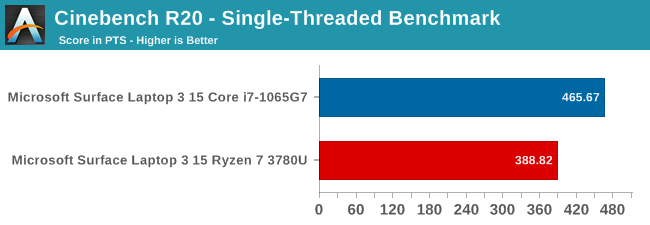
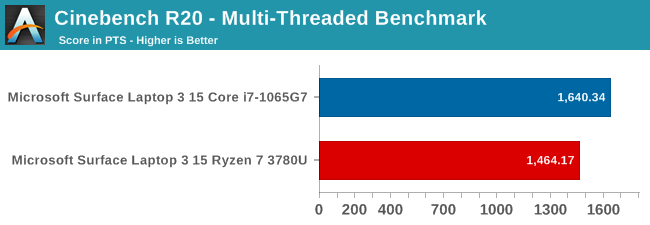
Looking at the latest version of Cinebench tells a similar story as to what we’ve seen so far. Ice Lake’s significant IPC lead pulls it way ahead. On the multi-threaded test, the AMD platform does close the gap somewhat, which is similar to the SPEC rate 8 results.
7-Zip
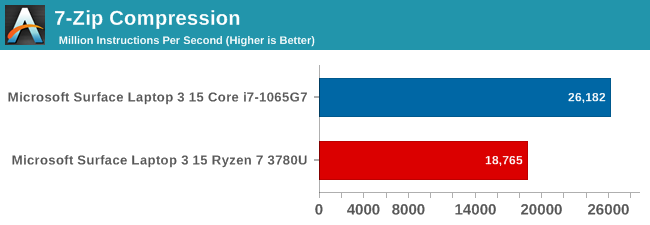
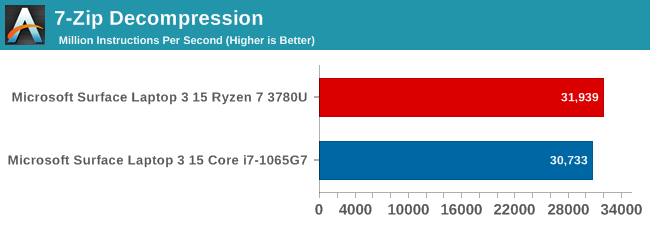
Checking out the popular 7-Zip file compression tool, the results are in-line with what we see in the desktop space. Intel generally has a lead on the compression side, but AMD claws back at decompression. It is a rare win on the CPU side for AMD here.
Handbrake
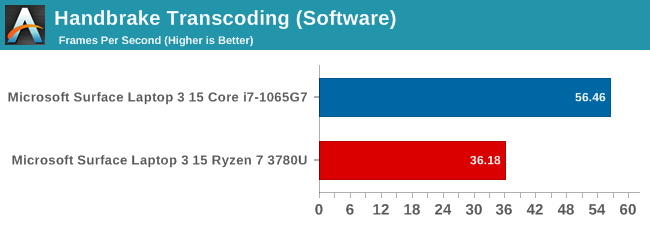
Transcoding is a popular task, and Handbrake is one of the most popular tools. For this test, a 1080p movie is converted to 720p using the x264 encoder. Once again, Ice Lake offers significantly more performance when transcoding in software.

Handbrake also supports various hardware encoders, such as Intel’s QuickSync, which provides significantly quicker transcodes at the same settings – albeit at larger file sizes and slightly lower quality compared to the software transcode, according to the Handbrake documentation. QuickSync has been very popular, and has been around quite a while. AMD also offers hardware encoding and decoding with their Video Core Next platform. Handbrake does support AMD’s Video Coding Engine (VCE) but the Surface Laptop 3 does not offer this as an option in Handbrake, so it was not able to be tested. As this is the only current Ryzen mobile APU we’ve tested, it may be a driver issue specific to the Surface branded processor.
x264
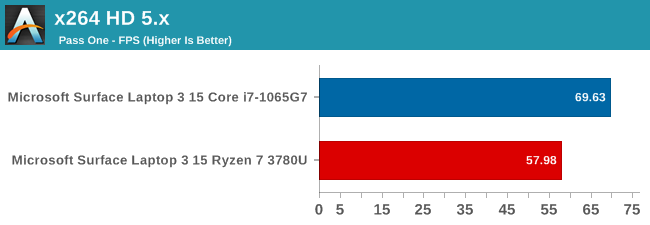
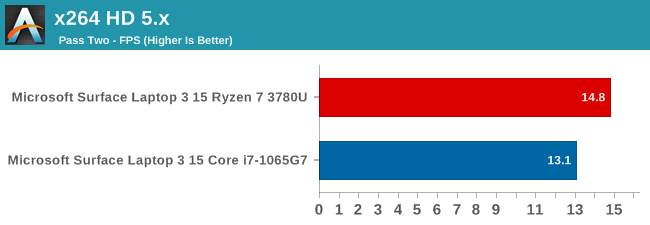
Our previous transcoding test, x264, was also run. Here we see that once again Ice Lake has a significant performance advantage, as it did with Handbrake software encoding.
Web Tests
All of our web tests were run with the current version of Microsoft Edge in Windows 10 1909. Web results are highly impacted by the underlying scripting engine, and Microsoft is going to be moving Edge from the EdgeHTML rendering engine to the Chromium open-source project that powers Google Chrome. When they make this change, expected early in 2020, we’ll revamp our suite with new tests.
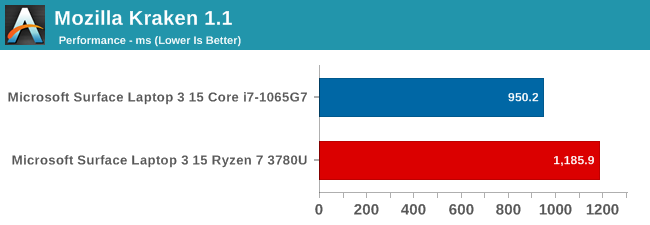

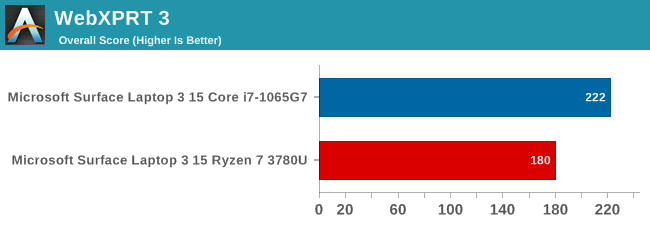
Intel has aggressively pushed their frequency ramping with Speed Shift, and one of the biggest beneficiaries of Speed Shift is web scripting, since the tasks tend to be very short. AMD is addressing this in Zen 2 with Collaborative Power Performance Control 2, or CPPC2, which is not as elegant of a name as Speed Shift, but promises to drop Zen’s frequency ramping from ~30 ms to ~1 to 2 ms, and will be a welcome addition on our web tests.










174 Comments
View All Comments
maroon1 - Sunday, January 12, 2020 - link
You mean LPDDR4XThere is big difference between LPDDR4 and LPDDR4X in speed
Llawehtdliub - Saturday, December 14, 2019 - link
Latest Intel CPU vs AMD's year old CPU.Doesn't seem very fair.
Brett Howse - Saturday, December 14, 2019 - link
And yet this is what is available as current gen products.m53 - Saturday, December 14, 2019 - link
It is as fair as comparing 5 year old Skylake with latest Zen2 desktop. The only difference is Skylake actually beats Zen2 if we compare “equal core count” parts. But here Zen+ is simply getting slaughtered by Ice Lake.0ldman79 - Tuesday, December 17, 2019 - link
This is Ice Lake, not Skylake.Not a 5 year old design.
This is, however, the two products that Microsoft has available to choose from.
Korguz - Tuesday, December 17, 2019 - link
m53. i doubt skylake can beat zen2, clock for clock, or core for core....0ldman79 but is based on a 5 year old design, so basically the same thing, hence why is 10th generation, not 1st generation
MBarton - Monday, December 30, 2019 - link
Wow, such a fanboy statement from a guy that whined about that fatality guy being a fanboy.maroon1 - Tuesday, December 17, 2019 - link
WRONGRyzen 7 3780U came out this year.
It is based on 12nm Zen+ but AMD low power mobile is almost 1 year behind their desktop parts
Zen2 APU will be out in 2020, but intel will also have Tiger lake-U in 2020.
AnnoyedGrunt - Saturday, December 14, 2019 - link
I thought the article was very fair, given what is available from AMD and Intel in the mobile space.While these benchmarks show convincingly in favor of Intel, I was wondering if the performance difference was noticeable in "normal" user. Seems like the battery life is likely to be the most significant difference between the two (that the user would notice).
Have the authors been able to use these systems day to day to see what the responsiveness is like, whether you notice a difference loading office software, doing presentations, running excel, chrome, safari, etc?
I have a Dell mobile workstation for work, and just started testing a desktop workstation, and while I'm sure the desktop is faster in tests like these, I honestly don't notice a performance difference at all, except in the heaviest CAD work. Therefore I am curious of a user could really notice a difference between these two systems in typical use.
-AG
Samus - Saturday, December 14, 2019 - link
Ouch, well that's embarrassing.Why the hell did Microsoft even bother with a Ryzen model when its so inferior?